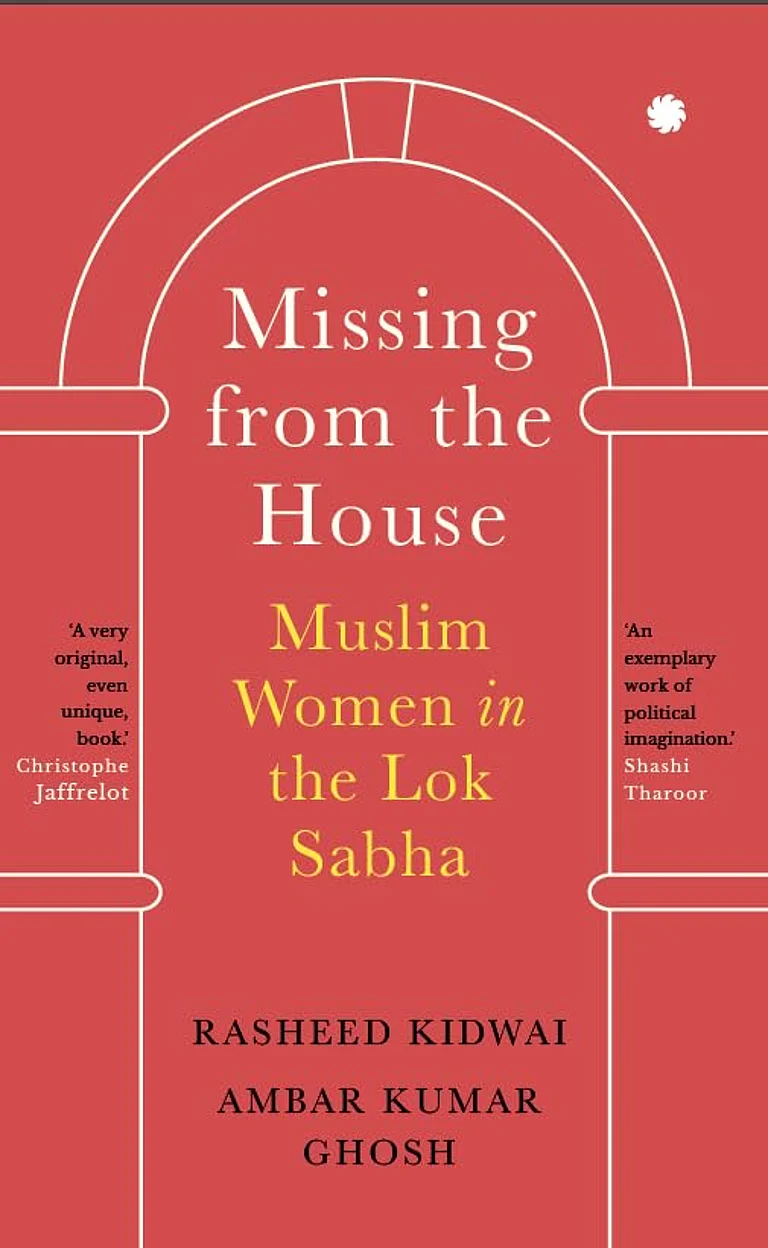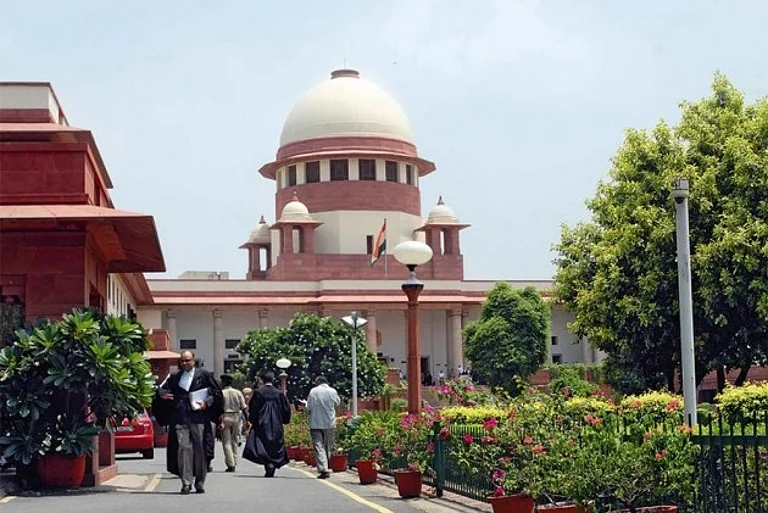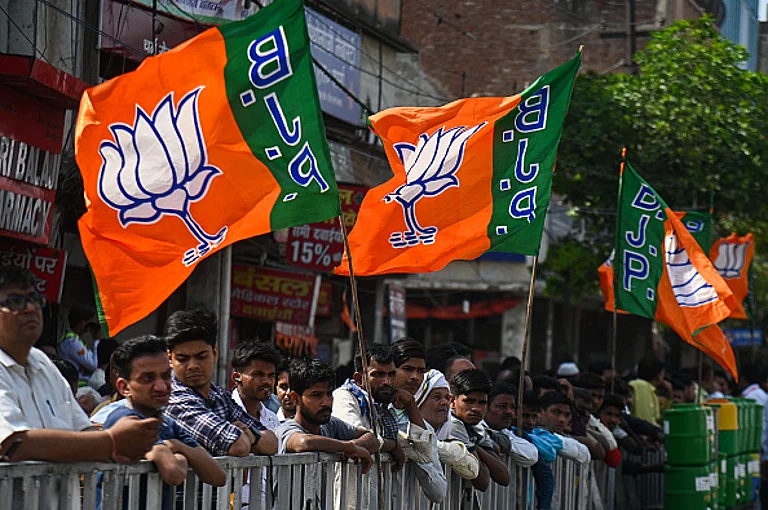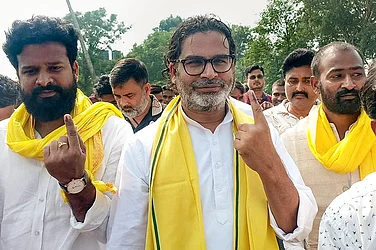Amid the fervour of Lok Sabha election 2024 in Uttar Pradesh, the elderly retiree Ravindra Singh Chaudhary spends his evenings locked in his sparse two-bedroom flat in Mahavir Chowk of Muzaffarnagar city. Located bang opposite an active railway line, Chaudhary’s train of thought is often interrupted by the grating squeals of actual trains passing at breakneck speed outside his window, even as he spends most of his evenings scribbling psephological calculations and percentages on a little notepad. He then sends the results of his laboured calculations to his friends and followers via WhatsApp.
Chaudhary is a known man in these parts. A former resident of Kawal village, located about 60 km from the city, Chaudhary is the father of Gaurav Singh, whose murder started the spiral of violence in 2013, now referred to as Muzaffarnagar riots. Communal tensions, which were already brewing in the region in August 2013 when Gaurav and his cousin Sachin Singh were murdered in Kawal after they allegedly killed a Muslim boy named Shahnawaz, came to a head on September 8 when clashes between Jats and Muslims broke out on in rural areas of Muzaffarnagar and Shamli districts. The ensuing violence left over 60 dead, even though local journalists and activists claim the number was much higher. The violence also left nearly 60,000 people - a majority of them Muslim - displaced from their home villages.
The violence altered the political and social fabric of Muzaffarnagar and west Uttar Pradesh, which was swept by the BJP in the 2014 Lok Sabha elections, the following year. Critics at the time had accused the BJP and RSS of politicising communal violence and even members of Sangh Parivar exacerbating divides. Two-time sitting Muzaffarnagar MP Sanjeev Balyan, a former veterinarian and Jat leader, emerged as one of the key faces of the Hindutva politics at the time and remained intrinsic in gaining support among Jats, a dominant landowning caste, which has previously supported leaders like Chaudhary Charan Singh and later his son Ajit Singh of Rashtriya Lok Dal (RLD) in UP.
Since the incident, Chaudhary and his daughters have moved from Kawal and don't plan on returning. The bereaved father is angry with the BJP and feels the party used his son's death to promote its electoral agenda, “The BJP government used our son’s photos in their banners and posters. Their names were taken in every election rally. Not just in 2014 but also in 2019,” Chaudhary states. Last year, Balyan had visited Kawal and held a prayer ceremony and conducted shanti path for the two deceased Jat boys. Chaudhary calls such gestures “stunts” to gain publicity by milking religious sentiment.
Chaudhary further rues that his family did not get any benefits from the government and even the charges against him for the murder of Shahnawaz were not dropped, despite repeated promises by leaders. Photos of the man meeting Yogi Adityanath and other BJP leaders adorn Chaudhary's wall. “Many people are angry with Balyan and others in the BJP,” Chaudhary states. He is referring to the disgruntlement that is being widely reported from the Rajput-Thakur community.
Considered BJP’s core voters in Uttar Pradesh, the Rajput community has produced many of the BJP’s top leaders including Yogi Adityanath and Rajnath Singh. Two weeks before the first phase of polls across eight seats in UP on April 19, community leader Thakur Puran Singh of Kisan Mazdoor Seva Sangathan addressed a Mahapanchayat in Saharanpur where they declared that they would vote for anyone but BJP. “Support of Rajputs is key to BJP winning so many seats in UP, especially in the west," he states. A similar “Swabhiman Mahapanchayat” was held in Khera village of Muzaffarnagar this week, 72 hours ahead of the polls and attended by representatives of Rajput groups like Rashtriya Rajput Karni Sena. “We are upset because they have neglected Thakurs. Kunwar Sarvesh Kumar Singh is the sole Rajput candidate contesting on a BJP ticket out of the 22 Lok Sabha seats in western UP. We need to show the government that it cannot function without us,” Thakur Puran Singh states. “Tyagis and Sainis are also upset,” states Amit Saini, an independent journalist based in Muzaffarnagar. Last week in Saharanpur, several leaders of Rajput-dominated civil societies attended a campaign rally by Congress candidate Imran Masood, infamous for his “boti boti” comment against Prime Minister Narendra Modi, and promised to support him.
While analysts believe that the majority of voters from these communities would eventually vote for "kamal (lotus)", a shift in core voters and "plus voters" away from the party may hurt its prospects in some seats. As Outlook travelled through Western UP, voices of discontent echoed through the sugarcane belts.
Chaman Singh is an affluent farmer whose family hosted a rally for BJP’s Balyan in Yahiyapur village, about 30 km from the city. The owner of about 90 acres of farmland, Singh, who is a Rawa Rajput, states that while they are happy with the BJP government, some problems persist. "Since the new laws against cow slaughter were implemented, the issue of stray cattle has become a real burden on farmers," says Singh, whose uncle was the village’s Pradhan, uncontested, for 30 years.
Another farmer, Beeram Singh, who owns about 30-35 beegha land in Hyderpura village of Bijnor states that there are no jobs for youth in the area, government schools don’t function well, and farmers continue to fetch low prices for sugarcane. “In the last five years, prices of sugarcane have only grown Rs 25. the price is now Rs 370/quintal. Inflation is much more than the growth in income,” Singh’s son Pinku, also a farmer, states. The 38-year-old wants his young children to go out of the state for studying because he feels that youth in the area lack educational opportunities.
Both the father-son duo and the Rawa Rajput farmers in Khatauli claim that roads have improved under ten years of BJP government in the Centre and seven years in the state. “Yogi ji has also increased the safety profile of these regions. Earlier, no woman could step out after dark and feel safe. Even men ran the risk of being killed, mugged or kidnapped. Yogi administration has been tough on criminals,” Singh states.
Pinku opines that this time, Samajwadi Party’s Deepak Saini, the INDIA alliance’s candidate from the Bijnor seat may manage to swing a significant share of votes. Palda village-based community leader and former senior journalist R Pratap Saini who claims to have quit journalism the day 2013 riots broke out, agrees. An influential Hindu community leader in the area, Saini says, “The comments made by BJP ministers in other states is also fuelling Rakput anger in UP.” He is referring to the comments made by Union Minister and BJP’s Rajkot seat candidate in Gujarat Parshottam Rupala's alleged offensive remarks about the history of Rajput kings. The Rajputs have sought action against Rupala and scrapping of his ticket.
Party insiders claim the Rajput anger goes beyond seats or insult. “There is a growing polarisation within the BJP between Yogi’s team and Amit Shah’s teams,” they state. The schism became even more visible after the feud between Rajput BJP leader Sangeet Shome and Balyan, a Jat, came to the fore. Unlike the popular perception of Western UP as being “Jatlands” or Jat-Gujjar majority areas, the Rajputs are actually the third largest population in Western UP following Muslims and Schedule Caste communities. Estimated to be over 10 per cent of the state’s population, the Rajputs are situated mostly in areas like Ghaziabad, Gautam Buddha Nagar, Saharanpur, Meerut, Kairana, Muzaffarnagar, Baghpat, Bijnor, Nagina, Amroha, Moradabad, Sambhal, Aligarh, Hathras, Mathura, Agra, and Fatehpur Sikri in West UP. If the call for boycott of BJP given by Rajput leaders works on ground, the BJP might face a tough time.
In Muzaffarnagar itself, out of total 18 lakh voters in Muzaffarnagar, five lakh are Muslim, 2.5 lakh Dalits, 5.5 lakh OBCs (including Saini, Pal, Kashyap, Prajapati), 1.5 lakh Jats, 1 lakh Vaish, 1 lakh Thakurs and 1 lakh Brahmins-Tyagis). If Muslims follow their traditional pattern of supporting SP, analysts like Saini predict a neck-and-neck fight. Friday's election will be a prestige battle for leaders like Balyan and for the BJP in general. After a decade of communally charged politics of majority, this election season in UP is revealing strands of anti-incumbency. The party must find a way to woo back its core voters without losing out on the OBC and SC votes it has been trying to consolidate. A split in Hindu voters also puts the spotlight on Muslim voters, who form over 19 per cent of the state’s population.




























